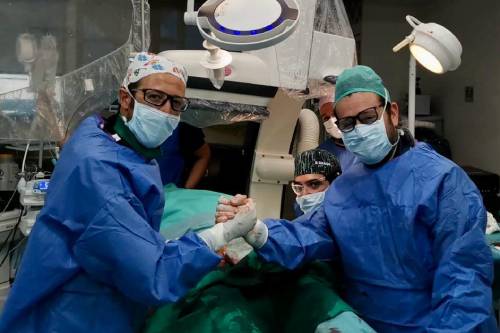
The knee is formed by the union of three bones: the femur, the tibia, and the patella. These bones are connected to each other by strong ligaments. The powerful muscles of the thigh and leg are inserted into the knee through tendons. However, there is one group
of patients with localized arthritis in a unique compartment of the knee. These patients may be able to beneficiate from a partial knee replacement, a surgery in which a smaller prosthesis replaces only the compartment damaged by arthritis.
What is unicompartmental knee replacement?
Your surgeon will make an incision over your knee, then remove the damaged tissue and bone.
A piece made of plastic and metal is placed on the knee. Once the piece is in place, it is fixed with bone cement, and finally the wound is closed with sutures.
Operation risk
As with all procedures, this carries some risks and complications
Common
- Pain: After the operation you will notice that the area is sore, over time the pain will fade. If the pain persists, call one of the doctors so that they can give you antibiotics.
- Bleeding: Sometimes a blood transfusion is required.
- Deep Vein Thrombosis: A blood clot in a vein. The risks of developing DVT are higher after any surgery. Your surgeon may give you medicine to try to limit your risk of DVT. Starting to walk as soon as possible is one of the best ways to prevent blood clots from forming.
- Stiffness: You may feel some stiffness in the operated area, but physical therapy will reduce stiffness.
- Replace the entire knee: If the surgeon sees that you have severe arthritis, he or she may decide to replace the knee completely.
- Wear of the prosthesis: knee implants usually last for many years, but in some cases they wear out, in this case talk to your doctor.
Less Common
-
Infection: The area where they have performed the operation may become painful or red, this may be signs of infection it may be necessary to take antibiotics to cure these infections.
Rare
- Pulmonary Embolism: Pulmonary embolism is a blood clot that affects the lungs.
- Altered Length: After the operation, it may appear to have one leg shorter than the other.
- Altered wound healing: The wound may become red, thickened, and painful (keloid scar), especially in Afro-Caribbean patients.
- Dislocation of the joint: If this occurs, the joint can usually be repositioned without the need for surgery. Sometimes this is not possible, and an operation is required.
- Damage to the nerves: There is a risk of damaging the nerves in the knee. There may also be damage to the perineal nerve, which can cause temporary or permanent weakness in the lower leg.
- Bone Damage-The bone may break when the prosthesis is inserted. This may require repair, either at the same time or at a later operation.
- Damage to blood vessels: The vessels in the back of the knee can rarely be damaged. may require more surgery.























